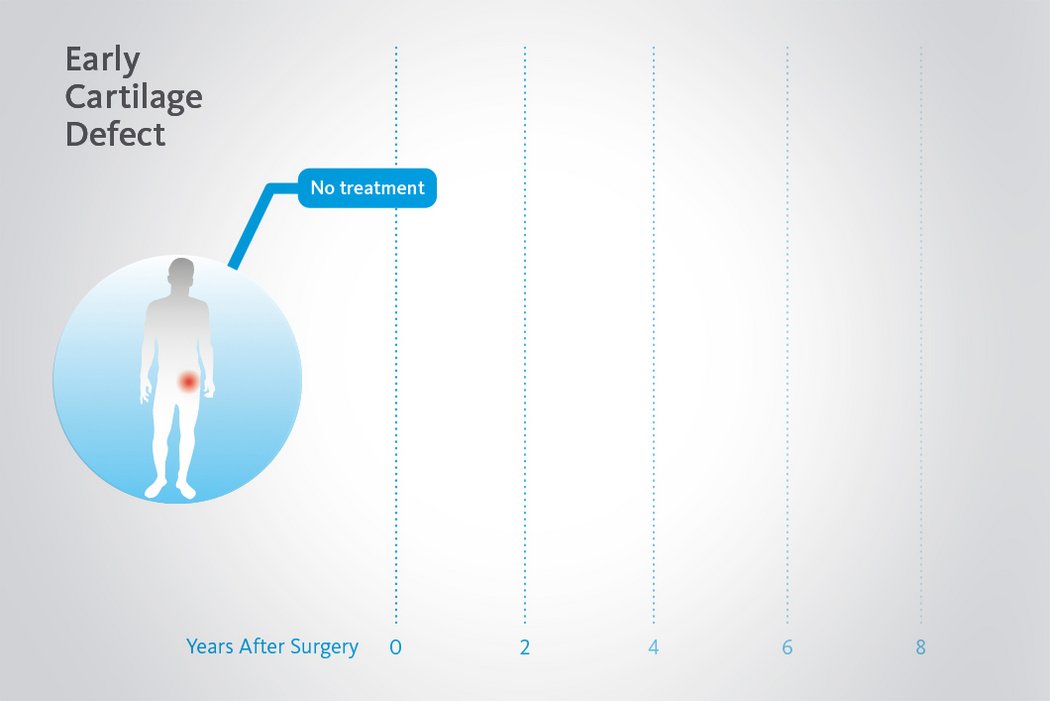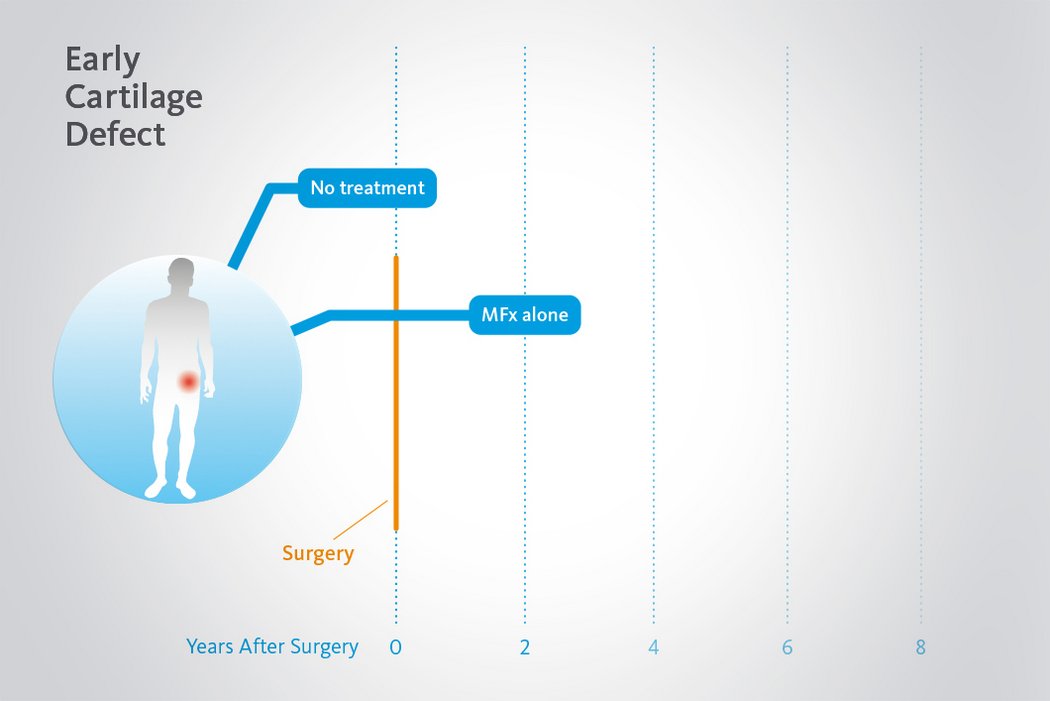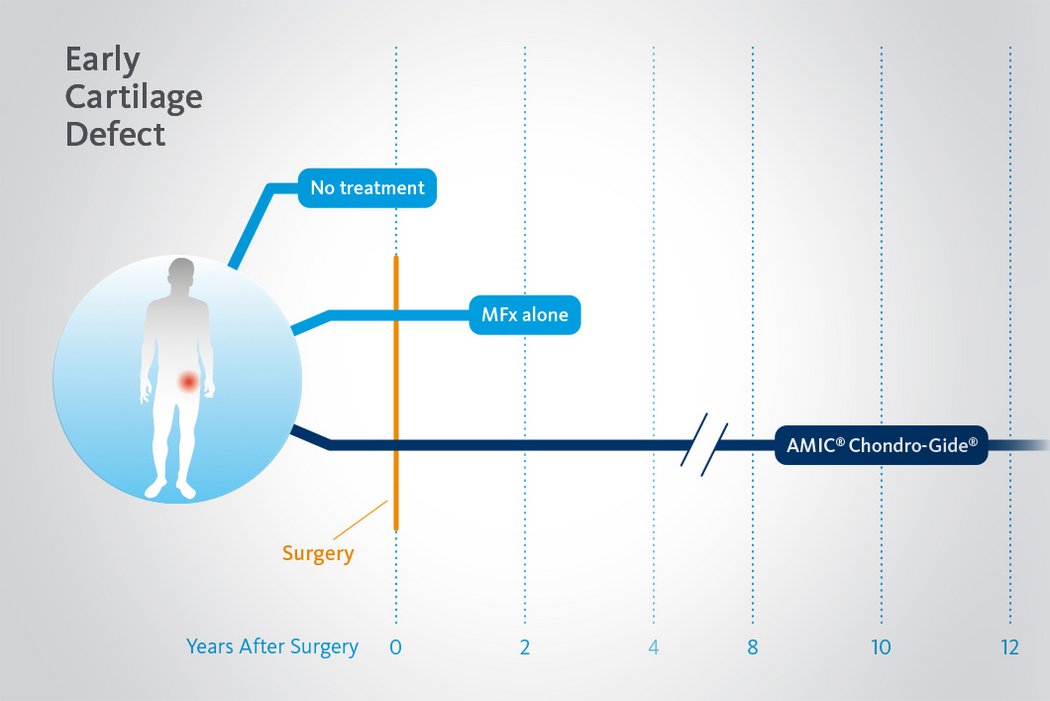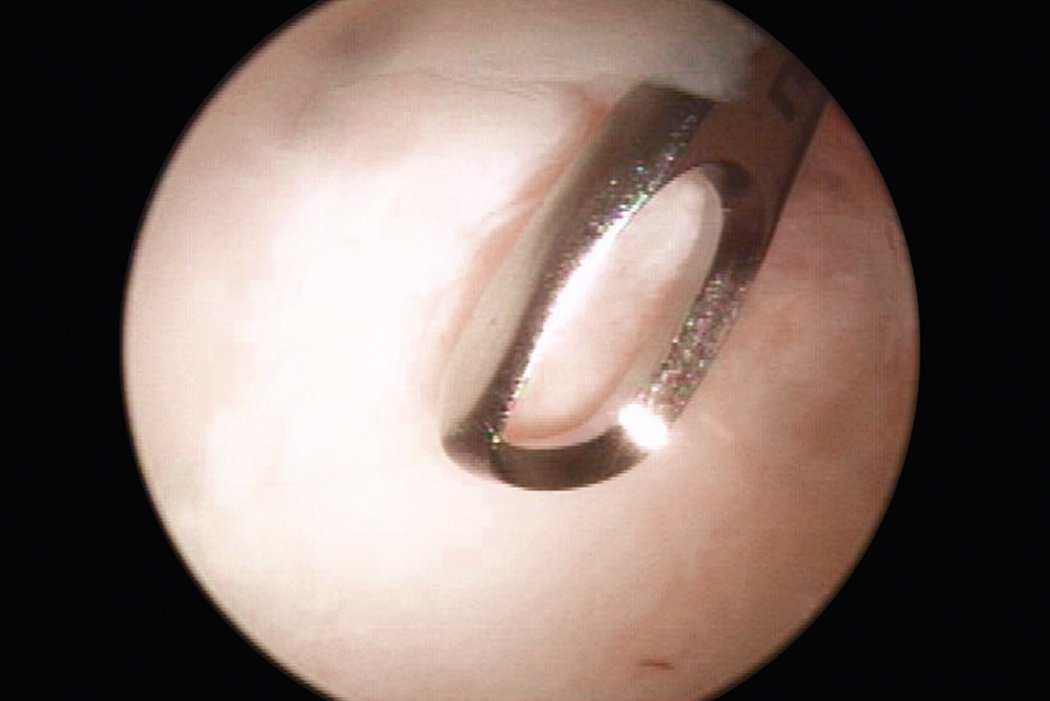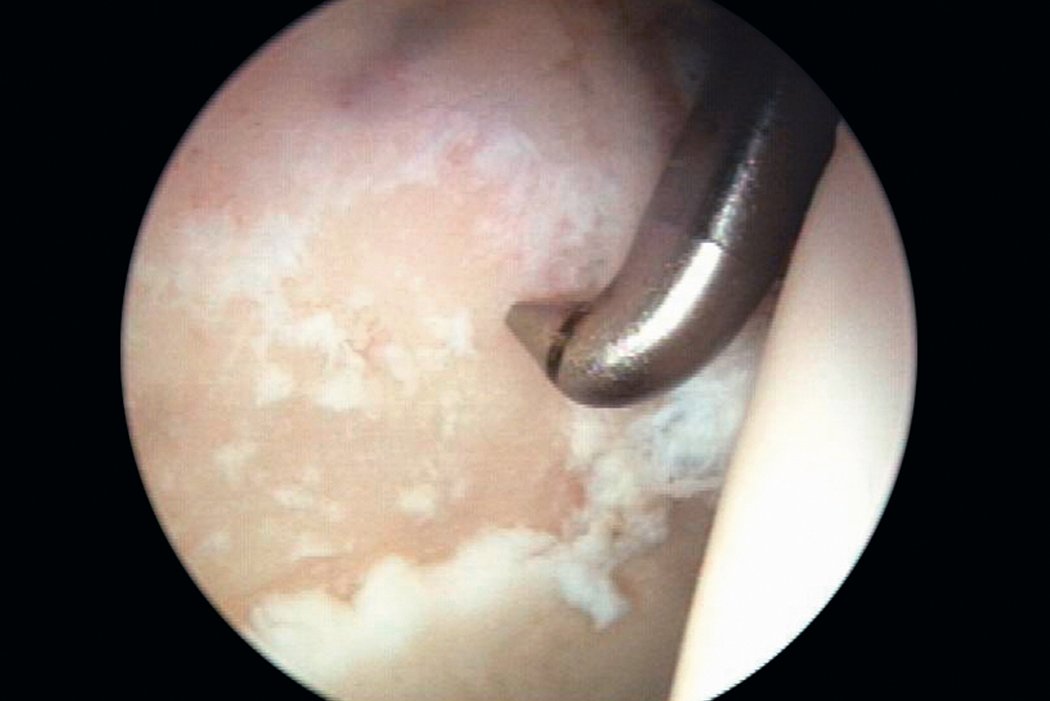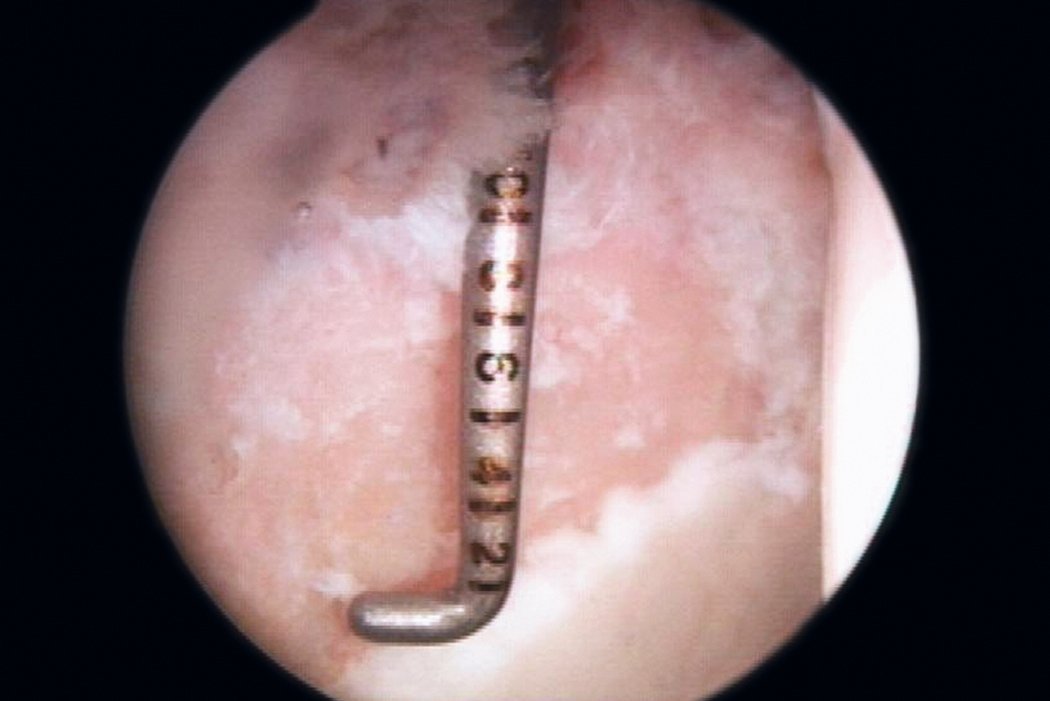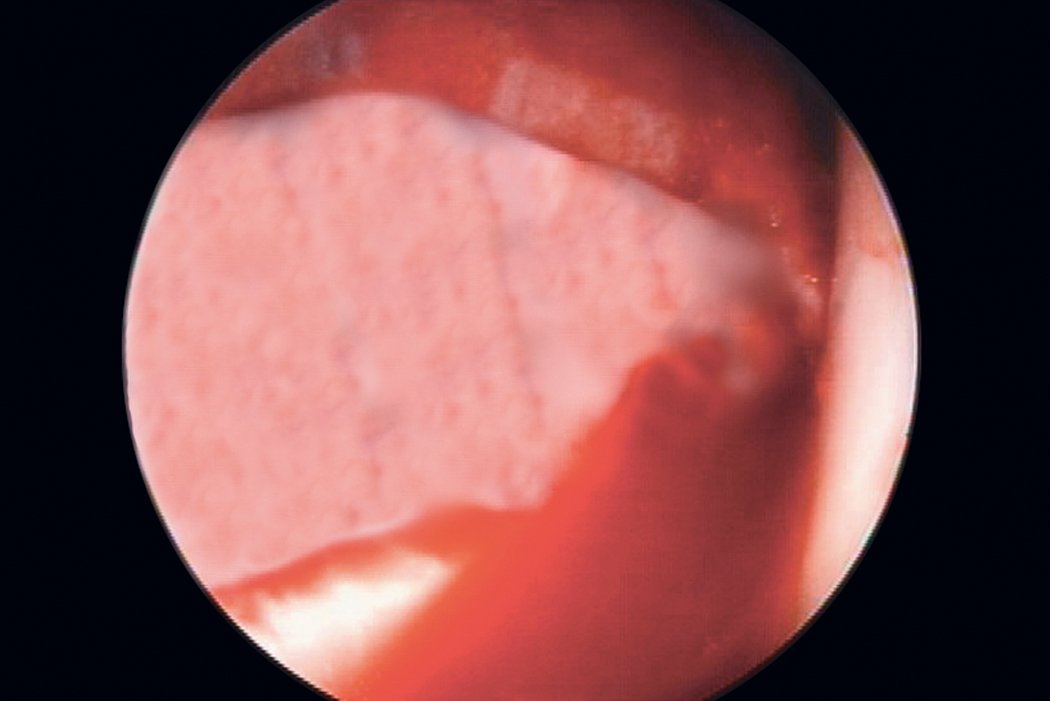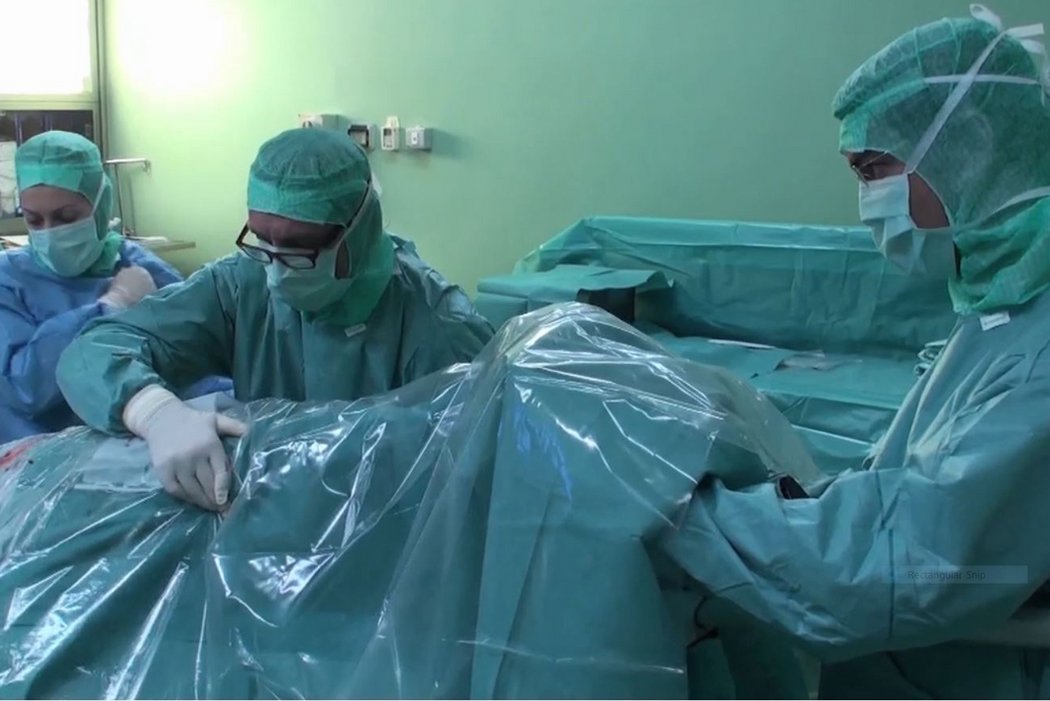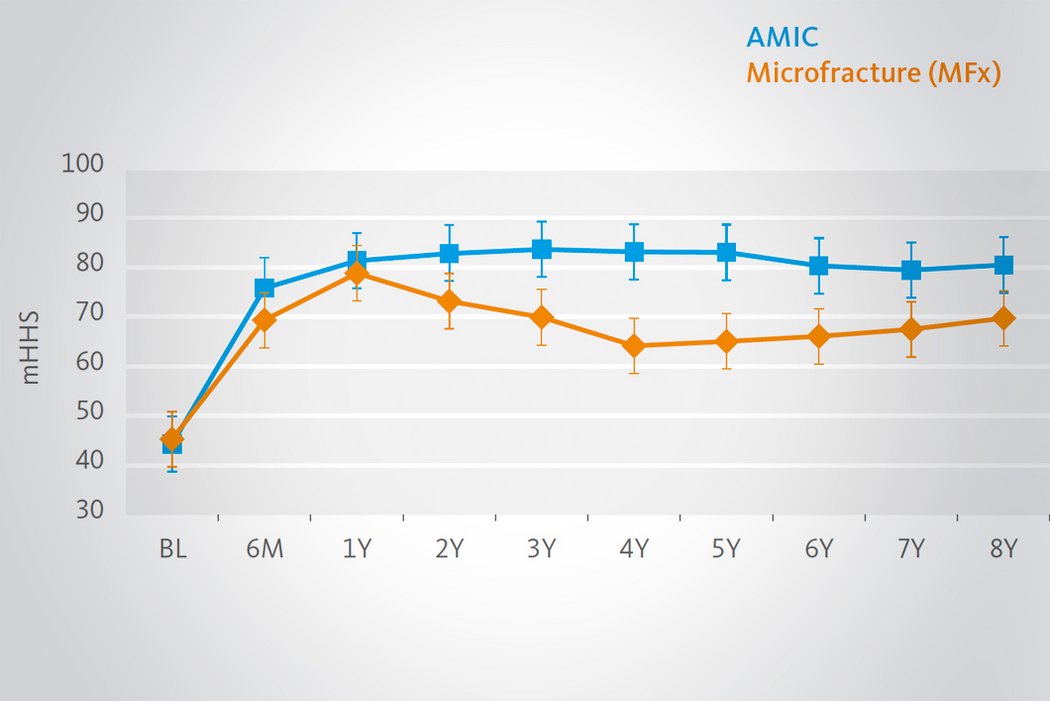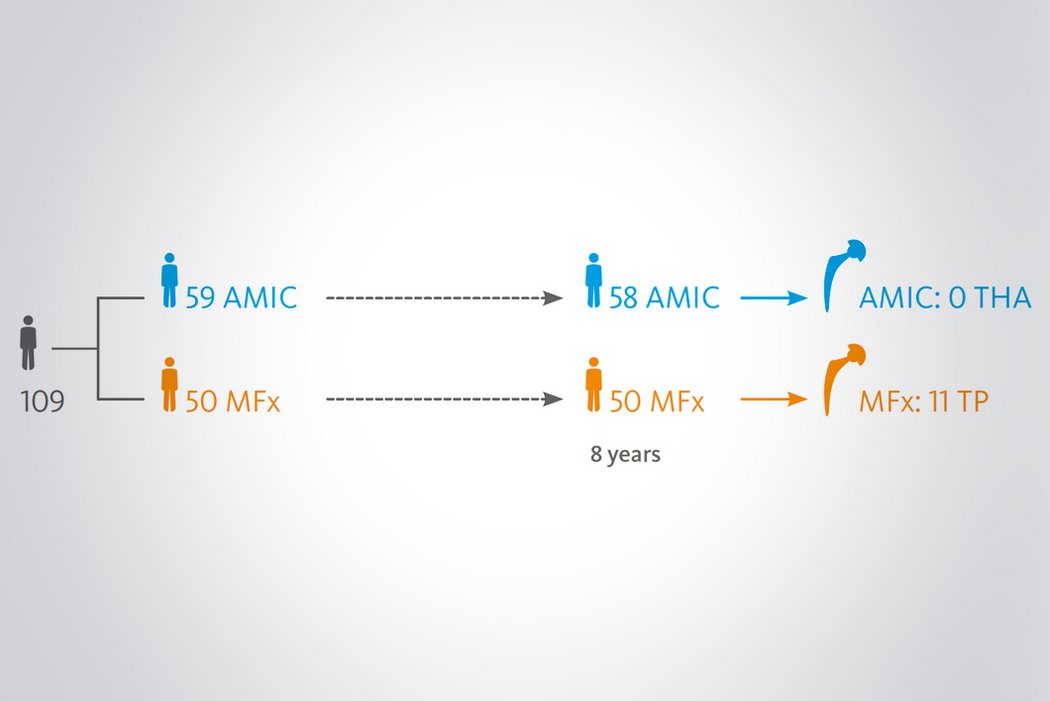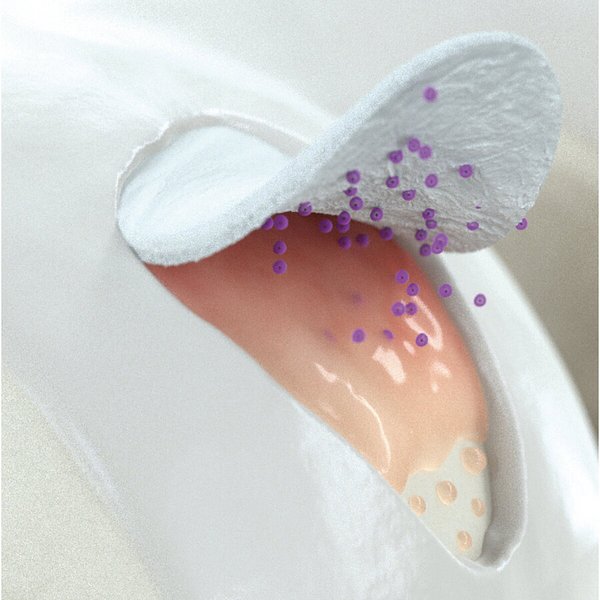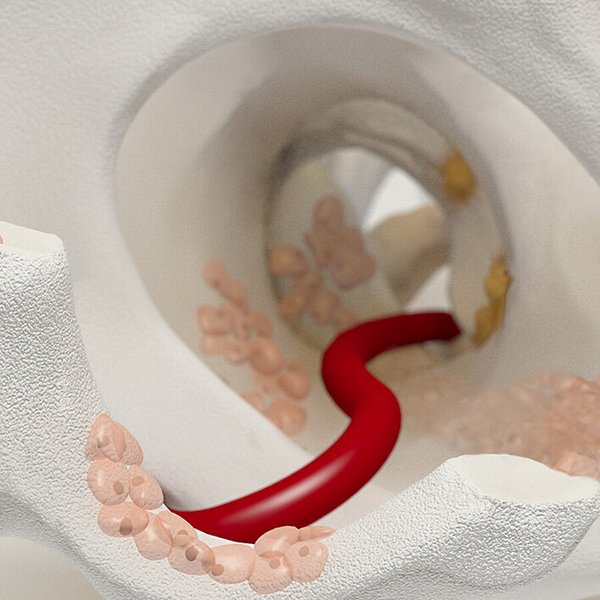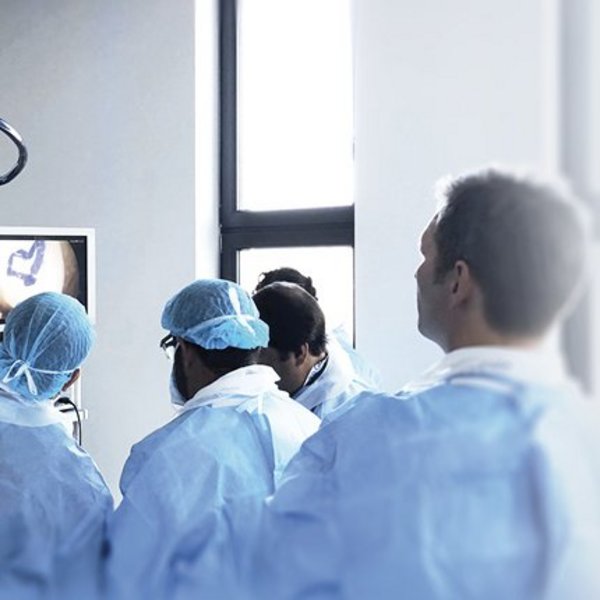AMIC® Chondro-Gide® - Hanche
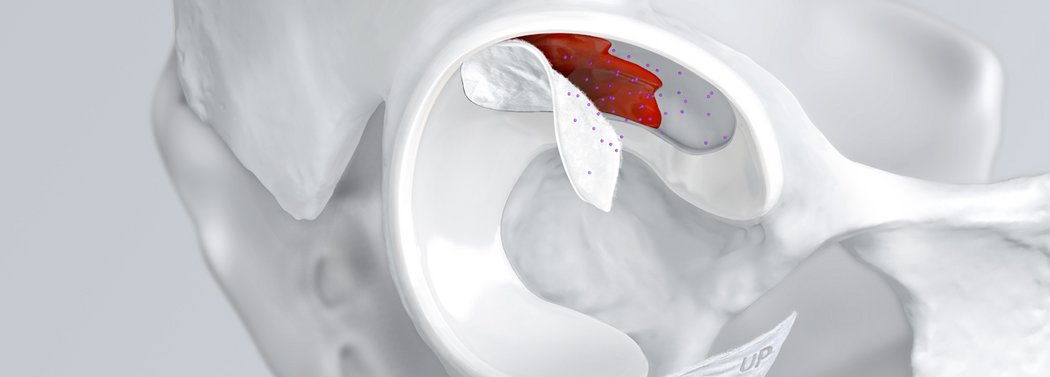
Les lésions chondrales de la hanche dues à un trauma, à une ostéonécrose, à une lésion du labrum ou à une autre cause peuvent entraîner de graves dysfonctionnements et des douleurs articulaires. Le conflit fémoro-acétabulaire (CFA) est une autre cause répandue de lésions localisées du cartilage et nécessite une arthroscopie1 de la hanche.
Il est désormais possible de retarder ou d’éviter la pose d’une prothèse de hanche
Le cartilage endommagé présente des capacités de régénération très limitées. Faute de traitement, la lésion peut s’aggraver au fil du temps. Grâce au traitement mini-invasif par arthroscopie des lésions chondrales de la hanche, il est désormais possible de préserver le cartilage de l’articulation de la hanche et de retarder et même, dans certains cas, d’éviter la chirurgie de remplacement complet de la hanche.
AMIC® Chondro-Gide® pour une régénération cartilagineuse efficace
AMIC® Chondro-Gide® est un procédé mini-invasif en une seule étape qui consiste à stimuler la moelle osseuse, en association avec Chondro-Gide, pour réparer toute lésion du cartilage, quelle que soit sa dimension.
Élaboré par Geistlich Surgery avec l’aide d’éminents chirurgiens européens, AMIC® Chondro-Gide® est un traitement2,3 efficace et économique permettant de régénérer le cartilage endommagé dans le talus, d’atténuer ou de prévenir la douleur, et de ralentir la progression de la lésion.
Grâce à sa structure bicouche unique, Chondro-Gide® offre un environnement protecteur qui favorise la formation de cartilage neuf.4,5
- Membrane de collagène I/III bicouche naturel4
- Biocompatible et naturellement résorbable4
- Facile à manipuler : souple et résistante4
- Peut être collée ou suturée4
- Compatible avec différentes techniques de régénération des tissus6
- Procédé en une seule étape4
- Prête à l’emploi4
Références
- MARQUEZ-LARA, A. et al., 2016, Arthroscopic Management of Hip Chondral Defects: A Systematic Review of the Literature. Arthroscopy: The Journal of Arthroscopic & Related Surgery. 2016. Vol. 32, no. 7, p. 1435-1443. DOI 10.1016/j.arthro.2016.01.058. Elsevier BV (Review).
- SCHIAVONE PANNI, A., et al. Good clinical results with autologous matrix-induced chondrogenesis (AMIC) technique in large knee chondral defects. Knee Surg Sports Traumatol Arthrosc, 2018 Apr 26(4):1130-36 (Clinical study).
- WALTHER, M., et al. Scaffold based reconstruction of focal full thickness talar cartilage defects. Clinical Research on Foot & Ankle, 2013, 1-5. (Clinical study).
- Geistlich Pharma AG data on file (Pre-clinical Study)
- GILLE, J., et al. Cell-Laden and Cell-Free Matrix-Induced-Chondrogenesis versus Microfracture for the Treatment of Articular Cartilage Defects: A Histological and Biomechanical Study in Sheep. Cartilage OnlineFirst, January 7, 2010, doi:10.1177/1947603509358721 (Pre-clinical study)
- KRAMER, J., et al. In vivo matrix-guided human mesenchymal stem cells. Cell Mol Life Sci, Mar 2006, 3(5), 616-626. (Clinical study)
- FONTANA, A. and DE GIROLAMO, L., 2015, Sustained 5-year benefit of autologous matrix-induced chondrogenesis for femoral acetabular impingement-induced chondral lesions compared with microfracture treatment. The Bone & Joint Journal. 2015. Vol. 97-B, no. 5, p. 628-635. DOI 10.1302/0301-620x.97b5.35076. British Editorial Society of Bone & Joint Surgery (Clinical study).
- DE GIROLAMO, L., et al., Autologous Matrix-Induced Chondrogenesis (AMIC) and AMIC Enhanced by Autologous Concentrated Bone Marrow Aspirate (BMAC) Allow for Stable Clinical and Functional Improvements at up to 9 Years Follow-Up: Results from a Randomized Controlled Study. Journal of Clinical Medicine. 2019. Vol. 8, no. 3, p. 392. DOI 10.3390/jcm8030392. MDPI AG (Clinical Study)
- Chondro-Gide® IFU 2019, Geistlich Pharma AG
- FICKERT, S. et al., 2017, Biologic Reconstruction of Full Sized Cartilage Defects of the Hip: A Guideline from the DGOU Group “Clinical Tissue Regeneration” and the Hip Committee of the AGA. Zeitschrift für Orthop.die und Unfallchirurgie. 2017. Vol. 155, no. 06, p. 670-682. DOI 10.1055/s-0043-116218. Georg Thieme Verlag KG (Guideline).
- FONTANA, A. and DE GIROLAMO, L., 2015, Sustained 5-year benefit of autologous matrix-induced chondrogenesis for femoral acetabular impingement-induced chondral lesions compared with microfracture treatment. The Bone & Joint Journal. 2015. Vol. 97-B, no. 5, p. 628-635. DOI 10.1302/0301-620x.97b5.35076. British Editorial Society of Bone & Joint Surgery (Clinical study).
- KAISER, N., et al. Clinical results 10 years after AMIC in the knee. Swiss Med Wkly, 2015, 145 (Suppl 210), 43S. (Clinical study).
- DE GIROLAMO, L., et al., 2018, Acetabular Chondral Lesions Associated With Femoroacetabular Impingement Treated by Autologous Matrix-Induced Chondrogenesis or Microfracture: A Comparative Study at 8-Year Follow-Up. Arthroscopy: The Journal of Arthroscopic & Related Surgery. 2018. Vol. 34, no. 11, p. 3012-3023. DOI 10.1016/j.arthro.2018.05.035. Elsevier BV (Clinical study).
- MANCINI, D., and FONTANA, A., 2014, Five-year results of arthroscopic techniques for the treatment of acetabular chondral lesions in femoroacetabular impingement. International Orthopaedics. 2014. Vol. 38, no. 10, p. 2057-2064. DOI 10.1007/s00264-014-2403-1. Springer Science and Business Media LLC (Clinical study).
Références
- MARQUEZ-LARA, A. et al., 2016, Arthroscopic Management of Hip Chondral Defects: A Systematic Review of the Literature. Arthroscopy: The Journal of Arthroscopic & Related Surgery. 2016. Vol. 32, no. 7, p. 1435-1443. DOI 10.1016/j.arthro.2016.01.058. Elsevier BV (Review).
- SCHIAVONE PANNI, A., et al. Good clinical results with autologous matrix-induced chondrogenesis (AMIC) technique in large knee chondral defects. Knee Surg Sports Traumatol Arthrosc, 2018 Apr 26(4):1130-36 (Clinical study).
- WALTHER, M., et al. Scaffold based reconstruction of focal full thickness talar cartilage defects. Clinical Research on Foot & Ankle, 2013, 1-5. (Clinical study).
- Geistlich Pharma AG data on file (Pre-clinical Study)
- GILLE, J., et al. Cell-Laden and Cell-Free Matrix-Induced-Chondrogenesis versus Microfracture for the Treatment of Articular Cartilage Defects: A Histological and Biomechanical Study in Sheep. Cartilage OnlineFirst, January 7, 2010, doi:10.1177/1947603509358721 (Pre-clinical study)
- KRAMER, J., et al. In vivo matrix-guided human mesenchymal stem cells. Cell Mol Life Sci, Mar 2006, 3(5), 616-626. (Clinical study)
- FONTANA, A. and DE GIROLAMO, L., 2015, Sustained 5-year benefit of autologous matrix-induced chondrogenesis for femoral acetabular impingement-induced chondral lesions compared with microfracture treatment. The Bone & Joint Journal. 2015. Vol. 97-B, no. 5, p. 628-635. DOI 10.1302/0301-620x.97b5.35076. British Editorial Society of Bone & Joint Surgery (Clinical study).
- DE GIROLAMO, L., et al., Autologous Matrix-Induced Chondrogenesis (AMIC) and AMIC Enhanced by Autologous Concentrated Bone Marrow Aspirate (BMAC) Allow for Stable Clinical and Functional Improvements at up to 9 Years Follow-Up: Results from a Randomized Controlled Study. Journal of Clinical Medicine. 2019. Vol. 8, no. 3, p. 392. DOI 10.3390/jcm8030392. MDPI AG (Clinical Study)
- Chondro-Gide® IFU 2019, Geistlich Pharma AG
- FICKERT, S. et al., 2017, Biologic Reconstruction of Full Sized Cartilage Defects of the Hip: A Guideline from the DGOU Group “Clinical Tissue Regeneration” and the Hip Committee of the AGA. Zeitschrift für Orthop.die und Unfallchirurgie. 2017. Vol. 155, no. 06, p. 670-682. DOI 10.1055/s-0043-116218. Georg Thieme Verlag KG (Guideline).
- FONTANA, A. and DE GIROLAMO, L., 2015, Sustained 5-year benefit of autologous matrix-induced chondrogenesis for femoral acetabular impingement-induced chondral lesions compared with microfracture treatment. The Bone & Joint Journal. 2015. Vol. 97-B, no. 5, p. 628-635. DOI 10.1302/0301-620x.97b5.35076. British Editorial Society of Bone & Joint Surgery (Clinical study).
- KAISER, N., et al. Clinical results 10 years after AMIC in the knee. Swiss Med Wkly, 2015, 145 (Suppl 210), 43S. (Clinical study).
- DE GIROLAMO, L., et al., 2018, Acetabular Chondral Lesions Associated With Femoroacetabular Impingement Treated by Autologous Matrix-Induced Chondrogenesis or Microfracture: A Comparative Study at 8-Year Follow-Up. Arthroscopy: The Journal of Arthroscopic & Related Surgery. 2018. Vol. 34, no. 11, p. 3012-3023. DOI 10.1016/j.arthro.2018.05.035. Elsevier BV (Clinical study).
- MANCINI, D., and FONTANA, A., 2014, Five-year results of arthroscopic techniques for the treatment of acetabular chondral lesions in femoroacetabular impingement. International Orthopaedics. 2014. Vol. 38, no. 10, p. 2057-2064. DOI 10.1007/s00264-014-2403-1. Springer Science and Business Media LLC (Clinical study).

Évidence clinique - AMIC® au niveau de la hanche
Fonctionnement de Chondro-Gide®
Chondro-Gide® forme un revêtement protecteur et permet de stabiliser les cellules libérées par l’os ou appliquées sur une lésion. La matrice Chondro-Gide® complète les méthodes de traitement régénératif des lésions chondrales et ostéochondrales. Lors des premières étapes du processus de régénération, Chondro-Gide® recouvre la lésion et les cellules qui se trouvent dans la lésion. Puis, après environ 4 mois9, il se résorbe et est remplacé par du tissu endogène.
Les avantages à long terme de la technique AMIC® Chondro-Gide® par rapport à la technique des microfractures seules (MFx)
L’utilisation de Chondro-Gide® pour les lésions cartilagineuses de la hanche est répandue. Les données recueillies 8 ans après l’opération démontrent les avantages à long terme de la technique AMIC® Chondro-Gide® par rapport à la technique MFx seule pour les défauts acétabulaires10,11,12. Dans une étude comparant la technique MFx sous arthroscopie seule avec la technique AMIC® Chondro-Gide®, De Girolamo et al.11,13 ont évalué 109 patients. Les patients présentant des lésions chondrales de la hanche associées à un conflit fémoro-acétabulaire (FAI) ont été traités par la technique AMIC® Chondro-Gide® ou MFx. Les patients des deux groupes avaient des âges similaires et présentaient des lésions de dimensions similaires en moyenne.
Références
- MARQUEZ-LARA, A. et al., 2016, Arthroscopic Management of Hip Chondral Defects: A Systematic Review of the Literature. Arthroscopy: The Journal of Arthroscopic & Related Surgery. 2016. Vol. 32, no. 7, p. 1435-1443. DOI 10.1016/j.arthro.2016.01.058. Elsevier BV (Review).
- SCHIAVONE PANNI, A., et al. Good clinical results with autologous matrix-induced chondrogenesis (AMIC) technique in large knee chondral defects. Knee Surg Sports Traumatol Arthrosc, 2018 Apr 26(4):1130-36 (Clinical study).
- WALTHER, M., et al. Scaffold based reconstruction of focal full thickness talar cartilage defects. Clinical Research on Foot & Ankle, 2013, 1-5. (Clinical study).
- Geistlich Pharma AG data on file (Pre-clinical Study)
- GILLE, J., et al. Cell-Laden and Cell-Free Matrix-Induced-Chondrogenesis versus Microfracture for the Treatment of Articular Cartilage Defects: A Histological and Biomechanical Study in Sheep. Cartilage OnlineFirst, January 7, 2010, doi:10.1177/1947603509358721 (Pre-clinical study)
- KRAMER, J., et al. In vivo matrix-guided human mesenchymal stem cells. Cell Mol Life Sci, Mar 2006, 3(5), 616-626. (Clinical study)
- FONTANA, A. and DE GIROLAMO, L., 2015, Sustained 5-year benefit of autologous matrix-induced chondrogenesis for femoral acetabular impingement-induced chondral lesions compared with microfracture treatment. The Bone & Joint Journal. 2015. Vol. 97-B, no. 5, p. 628-635. DOI 10.1302/0301-620x.97b5.35076. British Editorial Society of Bone & Joint Surgery (Clinical study).
- DE GIROLAMO, L., et al., Autologous Matrix-Induced Chondrogenesis (AMIC) and AMIC Enhanced by Autologous Concentrated Bone Marrow Aspirate (BMAC) Allow for Stable Clinical and Functional Improvements at up to 9 Years Follow-Up: Results from a Randomized Controlled Study. Journal of Clinical Medicine. 2019. Vol. 8, no. 3, p. 392. DOI 10.3390/jcm8030392. MDPI AG (Clinical Study)
- Chondro-Gide® IFU 2019, Geistlich Pharma AG
- FICKERT, S. et al., 2017, Biologic Reconstruction of Full Sized Cartilage Defects of the Hip: A Guideline from the DGOU Group “Clinical Tissue Regeneration” and the Hip Committee of the AGA. Zeitschrift für Orthop.die und Unfallchirurgie. 2017. Vol. 155, no. 06, p. 670-682. DOI 10.1055/s-0043-116218. Georg Thieme Verlag KG (Guideline).
- FONTANA, A. and DE GIROLAMO, L., 2015, Sustained 5-year benefit of autologous matrix-induced chondrogenesis for femoral acetabular impingement-induced chondral lesions compared with microfracture treatment. The Bone & Joint Journal. 2015. Vol. 97-B, no. 5, p. 628-635. DOI 10.1302/0301-620x.97b5.35076. British Editorial Society of Bone & Joint Surgery (Clinical study).
- KAISER, N., et al. Clinical results 10 years after AMIC in the knee. Swiss Med Wkly, 2015, 145 (Suppl 210), 43S. (Clinical study).
- DE GIROLAMO, L., et al., 2018, Acetabular Chondral Lesions Associated With Femoroacetabular Impingement Treated by Autologous Matrix-Induced Chondrogenesis or Microfracture: A Comparative Study at 8-Year Follow-Up. Arthroscopy: The Journal of Arthroscopic & Related Surgery. 2018. Vol. 34, no. 11, p. 3012-3023. DOI 10.1016/j.arthro.2018.05.035. Elsevier BV (Clinical study).
- MANCINI, D., and FONTANA, A., 2014, Five-year results of arthroscopic techniques for the treatment of acetabular chondral lesions in femoroacetabular impingement. International Orthopaedics. 2014. Vol. 38, no. 10, p. 2057-2064. DOI 10.1007/s00264-014-2403-1. Springer Science and Business Media LLC (Clinical study).
AMIC® par rapport à une greffe de chondrocytes autologues induite par matrice (MACI®)
Pendant 5 ans, Mancini et Fontana ont conduit une étude visant à comparer les résultats obtenus par les techniques AMIC® Chondro-Gide® et MACI pour le traitement de lésions chondrales acétabulaires de taille moyenne. La technique AMIC® offre des avantages supplémentaires en tant que procédure mini-invasive en une seule étape pouvant réduire la durée totale de traitement et la morbidité.
Pour plus d'informations sur Chondro-Gide® et sur les techniques opératoires ou pour plus de perspectives cliniques, télécharger la brochure .
Références
- MARQUEZ-LARA, A. et al., 2016, Arthroscopic Management of Hip Chondral Defects: A Systematic Review of the Literature. Arthroscopy: The Journal of Arthroscopic & Related Surgery. 2016. Vol. 32, no. 7, p. 1435-1443. DOI 10.1016/j.arthro.2016.01.058. Elsevier BV (Review).
- SCHIAVONE PANNI, A., et al. Good clinical results with autologous matrix-induced chondrogenesis (AMIC) technique in large knee chondral defects. Knee Surg Sports Traumatol Arthrosc, 2018 Apr 26(4):1130-36 (Clinical study).
- WALTHER, M., et al. Scaffold based reconstruction of focal full thickness talar cartilage defects. Clinical Research on Foot & Ankle, 2013, 1-5. (Clinical study).
- Geistlich Pharma AG data on file (Pre-clinical Study)
- GILLE, J., et al. Cell-Laden and Cell-Free Matrix-Induced-Chondrogenesis versus Microfracture for the Treatment of Articular Cartilage Defects: A Histological and Biomechanical Study in Sheep. Cartilage OnlineFirst, January 7, 2010, doi:10.1177/1947603509358721 (Pre-clinical study)
- KRAMER, J., et al. In vivo matrix-guided human mesenchymal stem cells. Cell Mol Life Sci, Mar 2006, 3(5), 616-626. (Clinical study)
- FONTANA, A. and DE GIROLAMO, L., 2015, Sustained 5-year benefit of autologous matrix-induced chondrogenesis for femoral acetabular impingement-induced chondral lesions compared with microfracture treatment. The Bone & Joint Journal. 2015. Vol. 97-B, no. 5, p. 628-635. DOI 10.1302/0301-620x.97b5.35076. British Editorial Society of Bone & Joint Surgery (Clinical study).
- DE GIROLAMO, L., et al., Autologous Matrix-Induced Chondrogenesis (AMIC) and AMIC Enhanced by Autologous Concentrated Bone Marrow Aspirate (BMAC) Allow for Stable Clinical and Functional Improvements at up to 9 Years Follow-Up: Results from a Randomized Controlled Study. Journal of Clinical Medicine. 2019. Vol. 8, no. 3, p. 392. DOI 10.3390/jcm8030392. MDPI AG (Clinical Study)
- Chondro-Gide® IFU 2019, Geistlich Pharma AG
- FICKERT, S. et al., 2017, Biologic Reconstruction of Full Sized Cartilage Defects of the Hip: A Guideline from the DGOU Group “Clinical Tissue Regeneration” and the Hip Committee of the AGA. Zeitschrift für Orthop.die und Unfallchirurgie. 2017. Vol. 155, no. 06, p. 670-682. DOI 10.1055/s-0043-116218. Georg Thieme Verlag KG (Guideline).
- FONTANA, A. and DE GIROLAMO, L., 2015, Sustained 5-year benefit of autologous matrix-induced chondrogenesis for femoral acetabular impingement-induced chondral lesions compared with microfracture treatment. The Bone & Joint Journal. 2015. Vol. 97-B, no. 5, p. 628-635. DOI 10.1302/0301-620x.97b5.35076. British Editorial Society of Bone & Joint Surgery (Clinical study).
- KAISER, N., et al. Clinical results 10 years after AMIC in the knee. Swiss Med Wkly, 2015, 145 (Suppl 210), 43S. (Clinical study).
- DE GIROLAMO, L., et al., 2018, Acetabular Chondral Lesions Associated With Femoroacetabular Impingement Treated by Autologous Matrix-Induced Chondrogenesis or Microfracture: A Comparative Study at 8-Year Follow-Up. Arthroscopy: The Journal of Arthroscopic & Related Surgery. 2018. Vol. 34, no. 11, p. 3012-3023. DOI 10.1016/j.arthro.2018.05.035. Elsevier BV (Clinical study).
- MANCINI, D., and FONTANA, A., 2014, Five-year results of arthroscopic techniques for the treatment of acetabular chondral lesions in femoroacetabular impingement. International Orthopaedics. 2014. Vol. 38, no. 10, p. 2057-2064. DOI 10.1007/s00264-014-2403-1. Springer Science and Business Media LLC (Clinical study).

